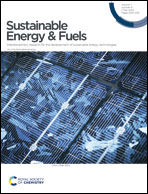Correlating nickel functionalities to selectivity for hydrogen peroxide electrosynthesis†
Abstract
The development of an environmentally friendly, safe and efficient method to produce hydrogen peroxide (H2O2) by electrocatalysis is an attractive alternative to the current anthraquinone autoxidation process. In this study, we investigated the morphology, chemical structure, and electrochemical performance of nickel decorated reduced graphene oxide prepared at various heat treatment temperatures in a slightly oxidizing atmosphere. The as-prepared material exhibited atomically dispersed nickel on the surface of reduced graphene oxide (rGO), while materials treated at 300 °C and 900 °C resulted in the formation of larger Ni nanoparticles on rGO. In addition to the morphology and particle size ratios, XRD, ToF SIMS and XPS also revealed the change in nickel/oxygen (Ni–O) functionalities, which led to a different electrochemical performance in terms of ORR activity, stability, and selectivity towards H2O2 production. Moreover, a clear correlation between Ni functionalities and selectivity for H2O2 production was demonstrated. From the results of this study, new selective electrocatalysts for green electrochemical H2O2 production can be designed in the future.

- This article is part of the themed collection: Recent Open Access Articles


 Please wait while we load your content...
Please wait while we load your content...